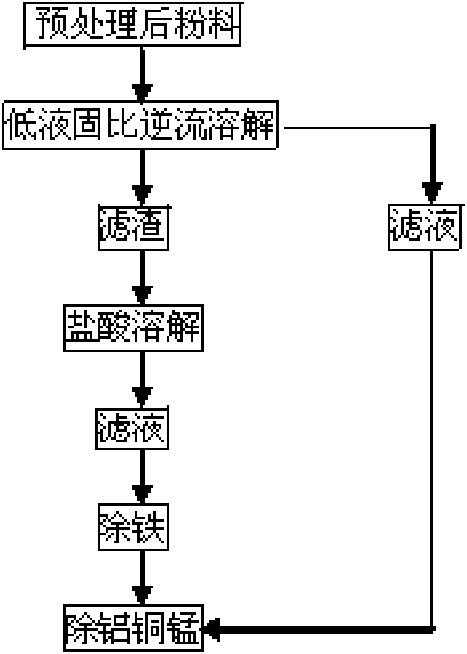Process for efficiently leaching anode active material of waste lithium battery
A technology for positive active materials and waste lithium batteries, which is applied in the field of high-efficiency leaching of positive active materials for waste lithium batteries, and can solve problems such as high cost, large environmental pollution, and low leaching efficiency
- Summary
- Abstract
- Description
- Claims
- Application Information
AI Technical Summary
Problems solved by technology
Method used
Image
Examples
Embodiment 1
[0018] Weigh and disassemble the waste lithium-ion battery to obtain 300g of powder material, which is ground to pass through an 80-mesh sieve (average particle size is less than 178 microns). Add 300ml of hydrogen peroxide (30wt%) and 600ml of a mixed solution with a sulfuric acid concentration of 2mol / L, and stir and leach in two stages at 80°C for 3 hours. After filtering, the filtrate is sent to the next purification and impurity removal process, and the remaining residue is stirred at 80°C for 1 hour with 2 mol / L hydrochloric acid at a solid-to-liquid ratio of 1:1 g / ml. Filter, and the filtrate is sent to the next stage of purification process. The leaching rate of the active material in this embodiment is about 96.5%.
Embodiment 2
[0020] Weigh and disassemble the waste lithium-ion battery to obtain 300 g of powder material, which is ground to pass through an 80-mesh sieve. Add 300ml of hydrogen peroxide (30wt%) and 600ml of a mixed solution with a sulfuric acid concentration of 4mol / L, and stir and leach in two stages at 90°C for 3 hours. Filter, and send the filtrate to the next stage of purification process, and use 2mol / L hydrochloric acid to make the solid-to-liquid ratio 1:1g / ml for the remaining residue, and stir at 80°C for 2 hours. Filter, and the filtrate is sent to the next stage of purification process. The leaching rate of the active material in this embodiment is about 98%.
Embodiment 3
[0022] Weigh and disassemble the waste lithium-ion battery to obtain 300 g of powder material, which is ground to pass through an 80-mesh sieve. Add 450ml of hydrogen peroxide (30wt%) and 600ml of a mixed solution with a sulfuric acid concentration of 4mol / L, and stir and leach in 5 stages at 90°C for 4 hours. Filter, and send the filtrate to the next stage of purification process, and use 3mol / L hydrochloric acid to make the solid-to-liquid ratio 1:1g / ml for the remaining residue, and stir at 90°C for 2 hours. Filter, and the filtrate is sent to the next stage of purification process. The leaching rate of the active material in this embodiment reaches 99%.
PUM
 Login to View More
Login to View More Abstract
Description
Claims
Application Information
 Login to View More
Login to View More - R&D
- Intellectual Property
- Life Sciences
- Materials
- Tech Scout
- Unparalleled Data Quality
- Higher Quality Content
- 60% Fewer Hallucinations
Browse by: Latest US Patents, China's latest patents, Technical Efficacy Thesaurus, Application Domain, Technology Topic, Popular Technical Reports.
© 2025 PatSnap. All rights reserved.Legal|Privacy policy|Modern Slavery Act Transparency Statement|Sitemap|About US| Contact US: help@patsnap.com

